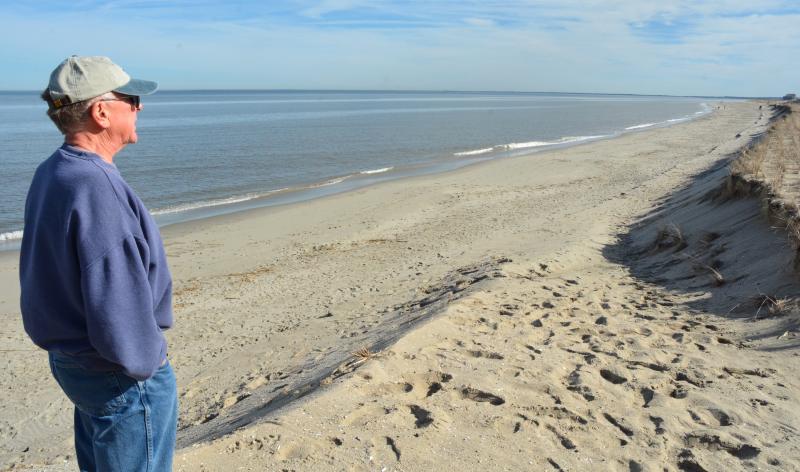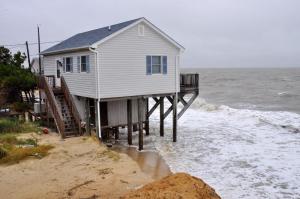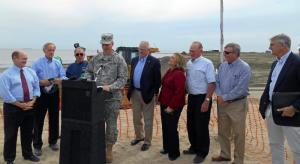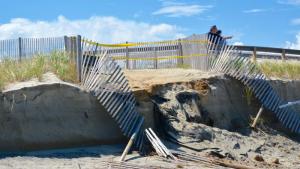Broadkill Beach looking for state to protect replenishment

A little more than four years ago, as part of a replenishment project, Broadkill Beach received nearly 2 million cubic yards of sand. Now, Broadkill residents and Sussex County officials are concerned the state may not do its part to protect the investment.
However, Delaware Department of Natural Resources and Environmental Control Secretary Shawn Garvin said the state wants to protect Broadkill Beach, and take advantage of federal funds, but not at the expense of depleting the state’s funding source used to protect other communities.
The deepening of the Delaware Bay shipping channel allows larger shipping vessels to make deliveries to the bay’s ports. As part of deepening the channel, the state and the U.S. Army Corps of Engineers brokered an agreement to put the spoils at Broadkill Beach. The project, completed in 2016, widened the beach by 150 feet and added a 16-foot dune.
Broadkill Beach resident Jim Bailey has been working with the state to protect the beach since 1994. He and his wife have owned a single-story concrete block home on North Bayshore Drive since 1983.
“We worked, worked, worked, until it came to fruition,” said Bailey, of getting Broadkill Beach replenished.
Bailey, a retired master electrician from Pennsylvania, said he wants Garvin to enter into a project partnership agreement with the corps that would enable Broadkill Beach to be put on a list for potential periodic nourishment – and so the state would not be on the hook for the whole bill in the case of an emergency.
Bailey said he and other Broadkill Beach residents do not understand why Garvin won’t move forward on an agreement with the corps. It just doesn’t make any sense that the state isn’t willing to maintain its investment, he said.
Ed Voigt, public and legislative affairs chief for the Philadelphia branch of the U.S. Army Corps of Engineers, said the corps establishes a project partnership agreement with nonfederal sponsors, such as a state, municipality or port authority, for construction of water resources projects, including replenishment.
Voigt said the agreement describes a project and responsibilities of the federal government and sponsoring agency in the cost sharing and execution of work. He said there are already agreements in place for periodic replenishments of the beaches in Rehoboth, Dewey, Bethany and South Bethany.
In an interview Feb. 6, Garvin said the problem with the agreement as proposed is that it calls for a full replenishment of the beach and dune resulting from the deepening project. There are challenges with the scope and cost, said Garvin, who noted it would cost the state an estimated $6.5 million as proposed. It’s all or nothing, he said.
Voigt said Broadkill Beach is unusual because a partnership is usually in place before replenishment takes place. Broadkill’s beach was replenished as a by-product of deepening the Delaware River. Periodic replenishment in the future will require the PPA, he said.
“One thing is for certain. Having a PPA does not guarantee the corps will be willing to move forward on a project, but not having one means it’s a 100 percent guarantee they won’t,” said Voigt.
Bailey has been Broadkill Beach Preservation Association president for all but one year since 1994. He and his neighbors aren’t the only ones who don’t understand why Garvin won’t move forward to sign the agreement.
During an Association of Coastal Towns meeting Jan. 24, Sussex County Administrator Todd Lawson was on hand to give mayors of the association’s seven towns an update on the county’s initiative to regulate wetland buffers and on the agreement with the corps. He said he was disappointed Garvin doesn’t want to sign the agreement.
Lawson said the county is trying to understand Garvin’s decision, and that he and other county officials would keep the discussion going.
“It’s very disappointing for us,” Lawson told the mayors.
Garvin said he wants to find a way to continue to protect Broadkill Beach. At this point, the discussion has only been rudimentary, but DNREC is continuing to look at agreement options with more flexibility, he said.
“We’re trying to find some sweet spot,” said Garvin.
Standing on Broadkill’s four-year-old man-made dune, Bailey looks out over Delaware Bay. He points across the bay at Cape May, N.J., and then to the wave-breaking walls on the Lewes side of The Point in Cape Henlopen State Park. Then he points to the mouth of the bay between the two.
“Broadkill Beach is unique. If there’s a northeast wind, there’s nothing out there breaking it,” said Bailey. “The next land mass is Iceland or Ireland, 1,000 miles away. This beach gets the same beating as an ocean beach gets.”
Bailey said DNREC would not be committing funds by signing the agreement. He said the agreement splits project costs 65/35 between federal and state governments. If the corps said it wanted to move forward with a replenishment, and the state didn’t have the funds available the corps would move on to the next project, he said.
Garvin said the state is always looking to take advantage of federal funds, but it can’t sacrifice the ability to participate on other projects for the benefit of Broadkill alone.
Bailey’s main concern is what happens if the PPA isn’t in place and a natural disaster hits.
“It will be 100 percent on the state to fix it,” he said.
Garvin said he appreciates the concern, but that alone is not a reason to enter an agreement that doesn’t work for the state and other bayside and ocean communities, which are also feeling the effects of global warming. There are going to be more of these projects, and they’re going to cost more, he said.
Bailey said the situation isn’t dire in Broadkill Beach – yet. He doesn’t want to see it get that way.
“We will never give up. We will never give up,” said Bailey.
Chris Flood has been working for the Cape Gazette since early 2014. He currently covers Rehoboth Beach and Henlopen Acres, but has also covered Dewey Beach and the state government. He covers environmental stories, business stories and random stories on subjects he finds interesting, and he also writes a column called Choppin’ Wood that runs every other week. He’s a graduate of the University of Maine and the Landing School of Boat Building & Design.


























































